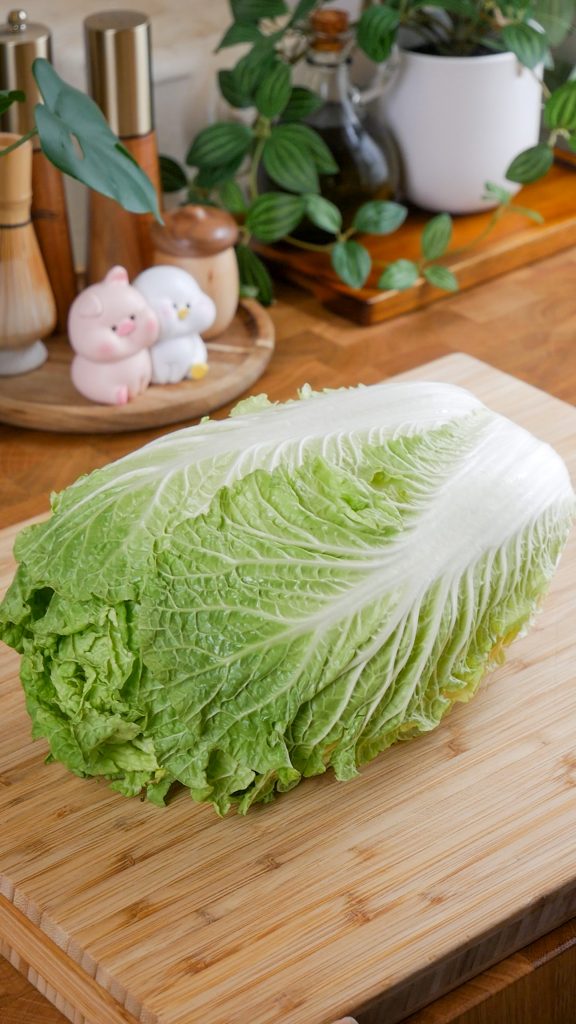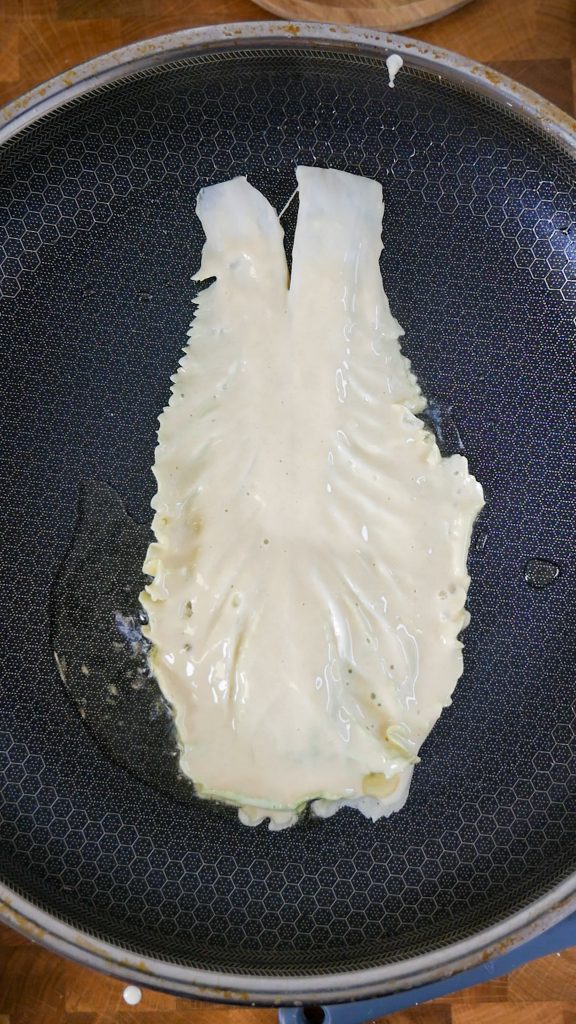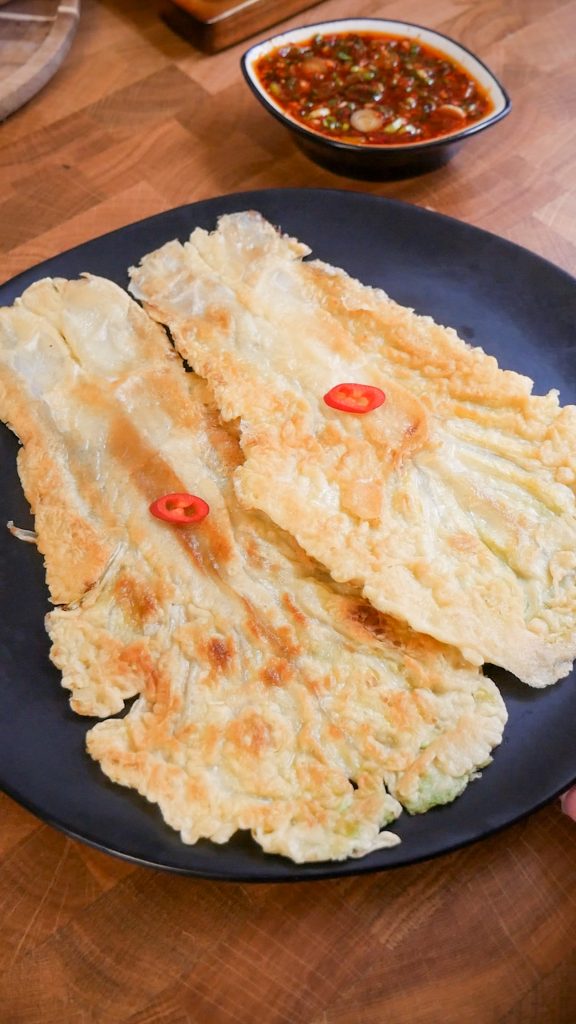Korean cabbage pancake or ‘baechu jeon’ is one of the simplest and most affordable yet delectable Korean pancake recipes. It’s made with just a handful of ingredients, ready in 25 minutes, and there’s no chopping needed! The result is a vegetable pancake that’s crispy on the outside and tender on the inside. Of course, I got to have it with Korean pancake dipping sauce, which I also shared my own recipe for in this blog.
Cabbage leaves are dipped in a light and flavorful batter with a bit of dashi and then shallow fried till golden brown and crispy. It’s much simpler than the usual vegetable pancakes recipe which is commonly made with zucchini, carrots, potato, and onions. Yet the taste won’t let you down. It’s still delicious! It pairs well with cabbage kimchi, too.
I like to serve Korean cabbage pancakes as an appetizer, snack, or side dish to go with other Korean dishes such as oyster ramen and marinated raw shrimp.

Why you’ll love this recipe
The main ingredient of this dish is napa cabbage leaves or ‘baechu’ which is also commonly used to make traditional kimchi. So if you’re making a batch of kimchi, you can also save some leaves and turn them into pancakes!
Napa cabbage is naturally bland, and that means it is a great vessel for carrying flavors and aromatics. Now the secret lies in the batter. I made a fairly simple but flavorful batter by adding a bit of dashi powder. Dashi powder is known for its savory and rich umami flavor and a little goes a long way. It gives the batter that extra underlying flavor boost without overpowering the cabbage. Dashi powder elevates any dish you add it to and even brings out the slight sweetness of napa cabbage in this one.
In terms of texture, cooked napa cabbage softens which is a delicious contrast between the light and crispy pancake batter. In my opinion, a savory Korean pancake is not complete without a dipping sauce and my Korean pancake dipping sauce is a must-have! Made with scallions, garlic, soy sauce, sesame, gochugaru, and rice vinegar for the perfect balance of savory, salty, and spicy that perfectly complements any Korean pancake like this ‘baechu jeon’. It also works well with dumplings, wonton, noodles, steamed fish, and other dishes. It’s chunky, just as I like it, so be sure to try it!

Korean Cabbage Pancake Ingredients and Substitutions
Napa cabbage leaves: While this recipe calls for the leaves of napa cabbage, the best part to use for this dish is actually the smaller inner leaves. They’re slightly sweeter and easier to work with due to their smaller size, however, it’s not a big deal if you use larger leaves. When buying napa cabbage in the market, look for ones that feel heavy for their size. The bright green leaves should be smooth, free from blemishes or any signs of bruises, and tightly wrapped on each other. That’s how you know they’re fresh!

Neutral oil: I like to use avocado oil but you can also use canola, vegetable, or peanut oil – any neutral-tasting oil with a high-smoke point works.
Dredge
All-purpose flour: It helps the batter hold its shape.
Rice flour: Helps contribute to the crispiness of the pancake.
Cornstarch: Added to make the batter light and crispy. You can substitute this with potato starch.
Salt: Seasons the pancake and bring out the natural flavor of napa cabbage.
Wet batter
Dredge: Using some of the dredge from above as the base of the wet better.
Egg: Adds some richness and body, and serves as the binder for the batter.
Dashi powder: For a boost of umami! While you can skip this, I highly recommend using it if you can! This can also be substituted with Korean beef bouillon called Dashida, chicken bouillon, or even mushroom bouillon.
Water: It helps all of the ingredients disperse and mix together.
How to Prepare Korean Cabbage Pancake
Step 1: Prepare the cabbage
Wash the napa cabbage leaves then drain well. Flatten the napa cabbage stems by gently pounding them with the dull side of a knife or rolling pin.



Step 2: Make the dredge
In a large mixing bowl, mix all-purpose flour, rice flour, cornstarch, and salt. Set aside 1/4 cup of the dredge for later.


Step 3: Make the light batter
To the large mixing bowl with the dredge, add an egg, dashi powder, and water. Mix until well combined and smooth. The consistency should resemble a thin pancake batter.





Step 4: Batter the cabbage
Coat a napa cabbage leaf in the dredge, making sure to get into the crevices on both sides. Dip the napa cabbage leaf into the wet batter, allowing the excess batter to drip.




Step 5: Pan fry the cabbage
In a large pan, heat 2 tablespoons of neutral oil over medium heat. Carefully place the battered napa cabbage leaf into the pan away from you to prevent getting splattered with oil. Pan fry for 2 to 3 minutes on each side or until golden brown and crispy.


Step 6: Serve
Serve with my delicious Korean Pancake Dipping Sauce (see note below). Enjoy!




Preparation Tips for Korean Cabbage Pancake
While this recipe is quite easy and straightforward, I believe you can never have too many tips! So, here are some expert tips to help ensure that your Korean cabbage pancakes will come out delicious every time.
- Napa cabbage has a naturally curved shape. To prevent it from curling up while cooking, I pound it with the back of my knife to flatten it out. Another way you can do this is by cutting short slits at the harder white part of the cabbage.
- Aside from frying whole individual leaves, you can also cut the cabbage into bite-size pieces and serve them as pancake chips.
- Always preheat the pan. This will help prevent the cabbage pancake from sticking. Preheating the pan is what also gives my Korean cabbage pancakes a nice beautiful color. And those brown bits are super tasty! Remember, more color means more flavor (unless it’s black, which means it’s burnt).
- Don’t overcrowd the pan. Overcrowding the pan might result in the cabbage pancakes sticking together. It will also cause the oil temperature to drop. If the oil is cold, the pancakes will absorb more oil and might come out soggy. I recommend pan-frying the leaves one or two at a time.
- The batter should be runnier than your regular pancake batter. It should lightly coat the back of a spoon. You can easily adjust the consistency by simply adding more water if it’s too thick and adding more flour if it’s too thin.
- What’s great about making your own pancake at home is that you can easily customize it to your liking! For example, sometimes I like to add bonito flakes just for added flavor. I sprinkle it on the pancake while the batter is still hot off the pan. You can also try adding pickled ginger, seafood, and even bacon bits!
- Serve it right away. Savory Korean pancakes are best eaten and the most crispy just right when they come out of the pan! It’ll naturally lose its crispiness the longer it sits.
- If you don’t have the ingredients to make my Korean dipping sauce, don’t worry. You can serve ‘baechu jeon’ with a simple dipping sauce made of 2 parts soy sauce soy sauce and 1 part sesame oil.
Frequently Asked Questions
Why is my Korean pancake not crispy?
Korean pancake will come out soggy if you cook it at a low temperature. If the oil isn’t hot enough, it gets absorbed by the pancake, resulting in a soggy pancake instead of a crispy one. To check if the oil is ready, simply stick one end of a wooden chopstick into the oil. If it starts to bubble, the oil is ready! If it doesn’t, you’ll need to heat it a bit longer. Another reason for soggy pancakes is overcrowding the pan, which also drops the oil temperature. Maintain an optimal cooking temperature by frying pancakes in batches.
Can you make gluten-free cabbage pancakes?
Yes, you can make this Korean cabbage pancake recipe gluten-free! Simply switch the all-purpose flour with almond flour or any gluten-free flour of your choice.
Can I make Korean cabbage pancakes ahead of time?
I do not recommend making them ahead of time as they naturally lose their crispiness the longer they sit. Korean pancakes are usually prepared one at a time, to ensure it’s enjoyed hot and fresh. However, if you really want to, you can make it in advance, and reheat it over the stovetop in a pan. Add a tablespoon of oil to the pan to reheat each pancake.
What is the difference between Korean cabbage pancake and okonomiyaki?
Both are fried vegetable pancakes and are usually served with a sauce; however, ‘baechu jeon’ derives from Korean, and ‘okonomiyaki’ comes from Japan. The batter for both pancakes might even be similar and interchangeable. However, okonomiyaki is made with more ingredients like pork, scallions, bonito flakes, and other types of vegetables. The cabbage in okonomiyaki is also chopped up into small pieces whereas ‘baechu jeon’ is a cabbage leaf fried in pancake batter.
Looking for more easy and delicious savory Korean pancake recipes?
- Korean Seafood Pancake — This crispy and savory seafood pancake is PACKED with scallions and of course, tons of seafood so you can expect this dish to burst with flavors. The pancake is soft on the inside, and crispy on the outside giving it a magical textural experience.
- Kimchi Seafood Pancake — This kimchi jeon is made with kimchi, scallions, peppers, and squid – perfect for seafood lovers! You can substitute the squid with pork, shrimp, mussels, chicken, or any protein that you prefer. It has a light and crispy texture that is perfect with a glass of makgeolli (Korean rice wine) on a cold or rainy day.
- Potato Cheese Pancakes — This garlicky cheesy potato pancake is inspired by the viral TikTok potato cheese pancake! It’s a delicious snack that marries mashed potatoes, sweet and aromatic roasted garlic, and melty ooey gooey cheese!
- Korean Oyster Pancake — Inspired by the popular Hong Kong-style oyster pancake, I made a mini version that’s more manageable to cook and easier to share. The batter is made with tempura frying mix and the fillings include oysters, scallions, and green peppers.
- Korean Vegetable Pancake — Light and crispy batter is achieved by multiple trial and error that I did so you don’t have to! These vegetable pancakes are filled with potatoes, zucchini, carrots, scallions, onions, and hot pepper, embedded in a super crispy pancake exterior.

Korean Cabbage Pancake Recipe – 배추전 (Baechu Jeon)
Ingredients
- 6 napa cabbage leaves
- 1/2 cup neutral oil divided, more if needed
Dredge
- 1/2 cup all-purpose flour
- 1/4 cup rice flour
- 2 tbsp cornstarch
- pinch of salt
Wet Batter
- 1/2 cup + 2 tbsp dredge from above
- 1 egg
- 1/2 tsp dashi powder
- 1/2 cup water
Korean Pancake Dipping Sauce
- see note 1
Instructions
- Wash the napa cabbage leaves then drain well. Flatten the napa cabbage stems by gently pounding it with the side of a knife or rolling pin.
- In a large mixing bowl, mix all-purpose flour, rice flour, cornstarch, and salt. Set aside 1/4 cup of the dredge for later.
- To the large mixing bowl with the dredge, add an egg, dashi powder, and water. Mix until well combined and smooth. The consistency should resemble a thin pancake batter.
- Coat a napa cabbage leaf in the dredge, making sure to get into the crevices on both sides. Dip the napa cabbage leaf into the wet batter, allowing the excess batter to drip.
- In a large pan, heat 2 tablespoons of neutral oil over medium heat. Carefully place the battered napa cabbage leaf into the pan away from you to prevent getting splattered with oil. Pan fry for 2 to 3 minutes on each side or until golden brown and crispy.
- Serve with my Korean Pancake Dipping Sauce (see note below). Enjoy!
Video
Notes
- Check out my Korean Pancake Dipping Sauce recipe!